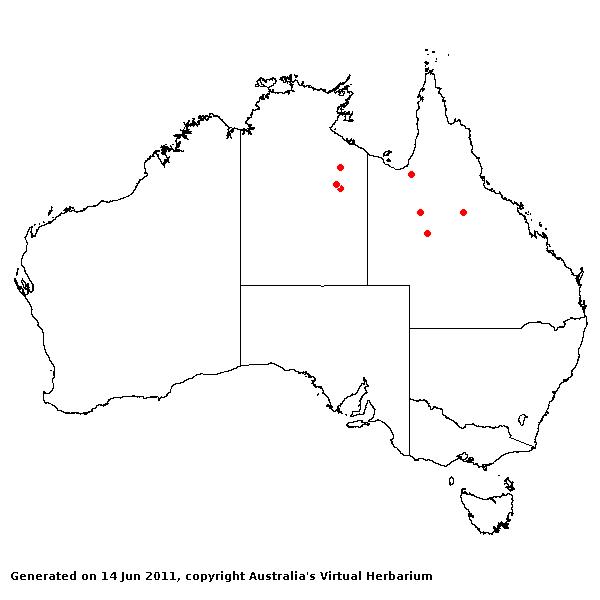Urochloa atrisola R.D. Webster. Australian
Paniceae (Poac.): 232 (1987).
Classification. (GPWG 2001) : Subfamily
Panicoideae. Paniceae.
Type of Basionym or
Protologue Information: HT: S. T. Blake 17776, 14 May 1947,
Australia: Northern Territory: Barkly Tableland, 17º20'S 135º45'E, undulating Astrebla
grassland, grey pedocalcic soil, 221 m, rich green tufts, more or less oblique
culms up to 30 cm long (BRI-186629; IT: BRI-065747, CANB, DNA, K, MO-4616119,
NT).
Recent synonyms:
Brachiaria atrisola.
Key references
(books and floras): [2002] D.Sharp & B.K.Simon, AusGrass, Grasses of
Australia (as Brachiaria).
Habit. Annual.
Rhizomes absent. Stolons absent. Culms geniculately ascending, 10–60 cm tall,
1–6 -noded. Mid-culm internodes glabrous. Mid-culm nodes glabrous. Lateral
branches branched. Leaf-sheaths glabrous on surface or hairy. Ligule a fringe
of hairs, 0.8–1.4 mm long. Leaf-blades linear or lanceolate, 3–15 cm long, 4–10
mm wide. Leaf-blade surface glabrous or indumented.
Inflorescence.
Inflorescence compound, a panicle of racemes. Racemes 2–4, 1.5–6 cm long, 3 mm
wide, bearing 6–16 fertile spikelets on each. Central inflorescence axis 4–15
cm long.
Spikelets.
Spikelets pedicelled. Fertile spikelets 2-flowered, the lower floret barren
(rarely male), the upper fertile, comprising 1 basal sterile florets,
comprising 1 fertile floret(s), without rachilla extension, elliptic, dorsally
compressed, 3.6–4.5 mm long.
Glumes. Glumes
dissimilar, thinner than fertile lemma. Lower glume oblate, hyaline, without
keels, 7–11 -nerved. Upper glume elliptic, 3.5–4.4 mm long, membranous, without
keels, 9 -nerved. Upper glume surface glabrous. Upper glume apex muticous. Florets.
Basal sterile florets 1, barren, without significant palea. Lemma of lower
sterile floret 100 % of length of spikelet, membranous, 5 -nerved.
Fertile lemma 3.4–4.3
mm long, without keel. Lemma apex mucronate. Palea without keels.
Continental
Distribution: Australasia.
Australian
Distribution: Northern Territory, Queensland.
Northern Territory:
Barkly Tableland. Queensland: Burke.
Notes.
Morphologically similar to the glabrous form of U. piligera but has a
rounded apex on the upper glume and lower lemma, turgid spikelets, relatively
larger spikelets and lacks the distinct callus at the base of the spikelet.
In arid and semi-arid
low woodlands and arid tussock grasslands. Restricted to the black-soils region
of Qld and the N.T. Flowers Mar.-May.



